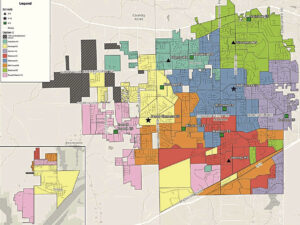Radon: A silent killer
By Staff
Thomas Tingle
Record Managing Editor
You can't see it, smell it, or taste it, but when it gets in your home, it can be deadly.
Radon – the second leading cause of lung cancer in the U.S. – is a radioactive gas that has been found in homes all across the country. In the air that surrounds us, radon typically disperses, but when it gets in a home, it can be a health risk. When high concentrations of radon are inhaled, it increases your risk of getting lung cancer.
A report by the National Academy of Sciences on radon estimates that radon causes between 15,000 and 22,000 lung cancer deaths each year in the United States. 10 to 15 percent of all lung cancers can be attributed to indoor radon.
According to Sabrina Lyle, a radon education technician with the Alabama Cooperative Extension System (ACES), the threat of radon getting into the air in your home is high in Madison County.
"Radon is a gas that comes from the natural breakdown of uranium in soil, rock, and water, and it gets into the air we breathe," Lyle said. "Radon gas typically moves up through the ground to the air above and can get into a home through cracks, openings around plumbing, and pipes or other holes in the foundation. Because you can't see it, smell it or taste it, testing is the only way to find out if you have radon in your home."
Here in Madison County and many other surrounding North Alabama counties, radon test kits are available at the Madison County Extension office for the subsidized price of $5, on the Radon in Alabama Web site, www.aces.edu/radon, or at a hardware store or other retail outlet.
"For a small amount of money, you can get a simple, easy-to-use radon test kit. Place the kit in your home according to the directions, drop it in the postage-paid mailer, and find out if your home has unhealthy levels of radon in it," Lyle said. "If you find out that it does contain high levels of radon, steps can be taken to fix the problem."
Information provided by the ACES shows that because a natural geologic condition, called karst, exists in North Alabama, different radon testing methods are recommended. Over time, geologic formations, such as large limestone rock formations, become weathered and form underground caves, cracks and channels. Such fissures serve as conduits to channel radon gas and cause unpredictable fluctuations in flow rates and patterns of movement depending upon the season of the year and outside environmental conditions.
"This causes radon levels to fluctuate more than in areas that don't have karst geology," Lyle said. "Radon levels can vary each day and each season. In karst areas, indoor radon levels have tended to test higher during the winter months of November through February and lower during warmer months. However, there are so many variables that cause radon levels to fluctuate that we cannot always say that they are higher in the winter. Although, based on existing knowledge we have for this area, it has proven the rule rather than the exception."
Lyle said since radon levels vary in this area, long-term monitoring should be considered. She said the extension's Alabama Radon Education Program provides long-term radon test kits for only $15 at the Madison County Extension office and can be ordered online through the radon web site.
"We recommend the test be done for 12 months to obtain the most reliable average of year-round radon levels in your home," Lyle said. "All you have to do is follow the instructions and return the test kits to the lab with the postage-paid mailer that is included."
The EPA estimates that one out of every 15 homes in the United States has elevated radon levels.
"Our program's database of radon tests completed in Alabama shows that nearly one out of three homes in Madison County has high radon levels," Lyle said. "It is becoming a growing concern here in the city of Madison with all of the new development going on – especially with mountainside development. Homes today are built very tight, relying on heating and air conditioning systems to move the air around. People don't open their windows like they used to. You can imagine the kind of air that exists in a lot of homes today. Such homes literally pull air out of the ground, much like a vacuum would."
However, Lyle said there is something you can do to prevent high radon levels in new homes.
"For as little as $250, a new home can be outfitted with a radon-ready system," Lyle said. "Instead of entering the home, the radon escapes through the pipe to the outside air, like a chimney. It can cost as much as $4,000 to get this pipe installed in an existing home, but most installations cost half of this amount or less. You can see how important it is to ask about radon prevention before construction begins. That way, for an additional $250, radon will be sent out of your home through the pipe rather than inside the home."
Across the country, 33 states require radon systems to be installed in homes during new construction. Recently, two municipalities in Alabama, Decatur and Hartselle, have adopted Appendix F, Radon Control Methods, with the International Building Code 2000, which requires new homes be built with radon-ready systems. Several other nearby towns are discussing adoption of the code.
"Decatur has taken the lead in enacting the first radon legislation in Alabama and that lead is being followed by neighboring towns," Lyle said.
Lyle said if you are considering purchasing a home, the U.S. Environmental Protection Agency recommends that the prospective buyer know what the indoor radon level is.
"If the home has been tested for radon, ask the seller for information on the tests used and results," Lyle said. "If the home hasn't been tested, it should be done before you buy. Any home can have a radon problem, new or old. Since you spend a lot of time in your home, it makes sense to have it tested for radon. The home is where you are most likely to get the greatest radiation exposure."
Lyle said she and her colleagues are spreading the word about radon gas, and it's a subject that is beginning to get a lot of attention. She said she's more than happy to provide educational material to local civic organizations, churches, and schools to spread the word.
One of the means used by the Alabama Radon Education Program to spread the word about radon and encourage testing is the Newborn Program, where new parents are given a packet of radon information along with a certificate for a free radon test kit. Huntsville Hospital has participated in the program since Oct. 2002, and distributes the packets at the hospital's birthing center.
"Our program encourages everyone to test their homes for radon," Lyle said. "Especially mothers and young children who are likely to spend the most time in the home. For their safety, isn't it better to find out now and do something about it before it's too late? This is one cause of lung cancer that can be prevented."
"It's something that you shouldn't be frightened about, but concerned," Lyle said. "It's a fixable problem."
Sidebar 1
Facts of radon
The amount of radon in the air is measured in picocuries of radon per liter of air (pCi/l). When a home's radon levels are 4 pCi/l or greater, the U.S. Environmental Protection Agency (EPA) recommends the radon be reduced or mitigated. This is the EPA's Action Level.
If your first short-term test result is 4 pCi/l or greater the EPA recommends a second test be done. If the average of the two tests is 4 pCi/l or greater, the EPA recommends you "fix" or mitigate the home of radon.
The EPA recommends that you have a qualified (certified) contractor fix your home because lowering high radon levels requires specific technical knowledge and special skills. However, if you decide to do the work yourself, get information on appropriate training courses and copies of the EPA's technical guide documents.
Between 1986 and February 2003, there have been 10,861 short-term radon tests completed in Madison County with 3,438, or 31.65 percent having elevated radon levels equal to or greater than 4 pCi/l of air. There have been 375 long-term radon tests completed, with 133, or 35.5 percent having elevated radon levels equal to or greater than 4 pCi/l of air.
Building a home radon-ready during construction is easier and cheaper than fixing a radon problem in an existing home. A home built radon-ready has a marketing advantage over homes without a radon-ready system. In addition to lowering the radon level in a home, radon-ready construction techniques can make a home more energy efficient and help save on energy costs. Radon-ready homes have been found to have fewer moisture problems from soil water vapor entry.
Sidebar 2
Some Madison County short-term radon test results as of Feb. 28, 2003
Zip Code
Total number of tests completed
Tests under 4 pCi/l
Tests greater than or equal to 4 pCi/l
Percent of tests over 4 pCi/l
35749
Harvest
22.41 %
35756
Madison
28.57 %
35757
Madison
19.12 %
35758
Madison
1,374
1,015
26.13 %
35773
Toney
20.98 %
Note: Results are based on independently tested homes from 1986 to February 28, 2003, not scientific sampling.
Sidebar 3
Zone 1 Radon Counties of Alabama map
Alabama has 15 Radon Zone 1 counties, those having the highest potential for high radon levels. The 15 Radon Zone 1 counties are: Calhoun, Clay, Cleburne, Colbert, Coosa, Franklin, Jackson, Jefferson, Lauderdale, Lawrence, Limestone, Madison, Morgan, Shelby and Talladega.

















